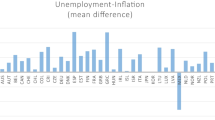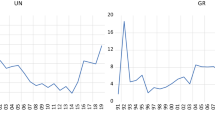Abstract
In this study, we examine the behaviour of unemployment in Nigeria using fractional integration & fractional cointegration techniques. Based on the fractional integration technique, we find that unemployment in Nigeria exhibits mean reverting properties but with a longer time horizon for any shock effect to fizzle out. The fractional cointegration technique reveals that unemployment shares somewhat common long run relationships with macroeconomic variables such as interest rate, inflation and output. Therefore, policy actions by relevant authority targeted at any of these macroeconomic variables may have implications on unemployment in Nigeria and vice versa. However, the results leading to these conclusions are sensitive to sample periods and intervening variables.

Similar content being viewed by others
Notes
Changes in the underlying equilibrium unemployment rate due to the interplay of changes in real macroeconomic variables and institutions. The structuralist school assumes that unemployment is mean-reverting towards an occasionally changing natural rate.
Excluding theoretical papers, the application of the FCVAR approach is limited, to the best of our knowledge, as few papers have been published in this regard. The most prominent involves commodity returns (see Dolatabadi, Nielsen, & Xu 2016; Dolatabadi et al. 2018) exchange rates (see Gil-Alana & Carcel 2018), Inflation persistence (Tule et al. 2020), Islamic stocks (Salisu et al. 2020), political support & economic voting (see Nielsen & Shibaev 2018; Jones, et al. 2014) and interlinkages between precious metals and Oil (Usman & Akadari, 2021).
We use the Nielsen and Popiel (2018) Matlab program to estimate both the CVAR and the FCVAR models.
References
Alogoskoufis GS, Manning A (1988) On the persistence of unemployment. Economic Policy 3(7):427–469
Arestis P, Mariscal IBF (1999) Unit roots and structural breaks in OECD unemployment. Econ Lett 65:149–156
Arestis P, Mariscal IBF (2000) OECD Unemployment: structural breaks and stationarity. Appl Econ 32:399–403
Ayala A, Cuñado J, Gil-Alana LA (2012) Unemployment hysteresis: empirical evidence for Latin America. J Appl Econ 15(2):213–233
Barro RJ (1995) Inflation and economic growth. No 5326, NBER Working Papers, National Bureau of Economic Research, Inc
Bianchi M, Zoega G (1997) Challenges facing natural rate theory. Eur Econ Rev 41:535–547
Bianchi M, Zoega G (1998) Unemployment Persistence: Does the size of the shock matter? J Appl Economet 13(3):283–304
Blanchard OJ, Summers LH (1986) Hysteresis and the European unemployment problem. NBER Macroecon Annu 1:15–78
Blanchard OJ, Summers LH (1987) Hysteresis in unemployment. Eur Econ Rev 31:288–295
Blanchard OJ, Katz LF, Hall RE, Eichengreen B (1992) Regional evolutions. In: Brookings papers on economic activity. vol 1992(1), pp 1–75
Brunello G (1990) Hysteresis and the Japanese unemployment problem: a preliminary investigation. Oxf Econ Pap 42(3):483–500
Caporale GM, Gil-Alana LA (2007) Nonlinearities and fractional integration in the US unemployment rate. Oxford Bull Econ Stat 69(4):521–544
Caporale GM, Gil-Alana LA (2008) Modelling the US, UK and Japanese unemployment rates: fractional integration and structural breaks. Comput Stat Data Anal 52(11):4998–5013
Caporale GM, Gil-Alana LA (2018) Unemployment in Africa: a fractional integration approach. S Afr J Econ 86(1):76–81
Central Bank of Nigeria (2019)Statistical database for macroeconomic variables. http://statistics.cbn.gov.ng. Accessed 15 Jan 2019
Decressin J, Fatas A (1995) Regional labor market dynamics in Europe. Eur Econ Rev 39(9):1627–1655
Dolatabadi S, Narayan PK, Nielsen MA, Xu K (2018) Economic significance of commodity return forecasts from the fractionally cointegrated VAR model. J Futur Mark 38(2):219–242
Dolatabadi S, Nielsen M, Xu K (2016) A fractionally cointegrated VAR model with deterministic trends and application to commodity futures markets. J Empir Financ 38B:623–639
Ebuh GU, Salisu A, Oboh V, Usman N (2021) A test for the contributions of urban and rural inflation to inflation persistence in Nigeria. Macroecon Finance Emerg Market Econ. https://doi.org/10.1080/17520843.2021.1974507
Friedman M (1968) The role of monetary policy. Am Econ Rev 58:1–17
Gil-Alana LA (2001a) A fractionally integrated exponential model for UK unemployment. J Forecast 20(5):329–340
Gil-Alana LA (2001b) The persistence of unemployment in the USA and Europe in terms of fractionally ARIMA models. Appl Econ 33(10):1263–1269
Gil-Alana LA (2002) Structural breaks and fractional integration in the US output and unemployment rate. Econ Lett 77(1):79–84
Gil-Alana LA, Carcel H (2018) A fractional cointegration var analysis of exchange rate dynamics. North Am J Econ Finance. https://doi.org/10.1016/j.najef.2018.09.006
Im KS, Pesaran MH, Shin Y (2003) Testing for Unit Roots in Heterogeneous Panels. Journal of Econometrics 115(1):53–74
Jaeger A, Parkinson M (1994) Some evidence on hysteresis in unemployment rates. Eur Econ Rev 38(2):329–342
Johansen S (1995) Likelihood-based inference in cointegrated vector autoregressive models. Oxford University Press on Demand, Oxford
Johansen S, Nielsen M (2012) Likelihood inference for a fractionally cointegrated vector autoregressive model. Econometrica 80:2667–2732
Jones M, Nielsen M, Popiel MK (2014) A fractionally cointegrated VAR analysis of economic voting and political support. Can J Econ 47:1078–1130
Layard R, Layard PRG, Nickell SJ, Jackman R (2005) Unemployment: macroeconomic performance and the labour market. Oxford University Press on Demand, Oxford
Lee J, Strazicich MC (2003) Minimum Lagrange multiplier unit root test with two structural breaks. Rev Econ Statist 85(4):1082–1089
Lee J, Strazicich MC (2003b) Minimum Lagrange multiplier unit root test with two structural breaks. Rev Econ Stat 85(4):1082–1089
Levin A, Lin CF, Chu C (2002) Unit root tests in panel data: asymptotic and finite-sample properties. J Econ 108(1):1–24
Lumsdaine RL, Papell DH (1997) Multiple trend Breaks and the unit-root hypothesis. Rev Econ Statist 79(2):212–218
Mitchell WF (1993) Testing for unit roots and persistence in OECD unemployment rates. Appl Econ 25(12):1489–1501
Narayan PK, Liu R, Westerlund J (2016) A GARCH model for testing market efficiency. J Int Finan Markets Inst Money 41:121–138
National Bureau of Statistics (2019) Statistical database for urban and rural inflation rates. http://www.nigerianstat.gov.ng/elibrary. Accessed 15 Jan 2019
Nelson CR, Plosser CR (1982) Trends and random walks in macroeconmic time series: some evidence and implications. J Monet Econ 10(2):139–162
Nielsen MA, Shibaev SS (2018) Forecasting daily political opinion polls using the fractionally cointegrated vector autoregressive model. J R Stat Soc Ser A 181(1):3–33
Nielsen MA, Popiel MK (2018) A Matlab program and user’s guide for the fractionally cointegrated VAR model. Queen’s Economics Department Working Paper No. 1330.
Okun AM, Fellner W, Greenspan A (1973) Upward mobility in a high-pressure economy. Brook Pap Econ Act 1973(1):207–261
Papell DH, Murray CJ, Ghiblawi H (2000) The structure of unemployment. Rev Econ Stat 82(2):309–315
Perron P (1989) The great crash, the oil price shock, and the unit root hypothesis. Econ J Econ Soc 57:1361–1401
Perron P (1997) Further evidence on breaking trend functions in macroeconomic variables. J Econ 80(2):355–385
Phelps E (1968) Money-wage dynamics and labor-market equilibrium. J Polit Econ 76(4):678–711
Phelps ES (1972) Inflation policy and unemployment theory
Phelps ES (1967) Phillips curves, expectations of inflation and optimal unemployment over time. Economica 34:254–281
Roed K (1996) Unemployment hysteresis-macro evidence from 16 OECD countries. Empiric Econ 21(4):589–600
Romer C (2011) The continuing unemployment crisis: causes, cures, and questions for further study. In: Speech presented at livable lives initiative symposium. Washington University, Vol 12
Salisu AA, Ndako UB, Adediran IA, Swaray R (2020) A fractional cointegration VAR analysis of Islamic stocks: a global perspective. North Am J Econ Finance 51:101056
Song FM, Yangru WU (1997) Hysteresis in unemployment evidence from 48 US states. Econ Inq 35(2):235–243
Song FM, Wu Y (1998) Hysteresis in unemployment: evidence from OECD countries. Q Rev Econ Finance 38(2):181–192
Song FM, Yangru W (1997) Hysteresis in unemployment evidence from 48 US states. Econ Inquiry 35(2):235–243
Sowell F (1992) Modeling long-run behavior with the fractional ARIMA model. J Monet Econ 29(2):277–302
Tule MK, Ajilore TO, Ebuh GU (2016) A composite index of leading indicators of unemployment in Nigeria. J Afr Bus 17(1):87–105. https://doi.org/10.1080/15228916.2016.1113909
Tule MK, Chiemeke CC, Oduh MO, Ndukwe CO (2017a) Assessing the severity of unemployment in Nigeria. J Afr Bus 19(4):1–23. https://doi.org/10.1080/15228916.2017.1343031
Tule MK, Egbuna EN, Dada E, Ebuh GU (2017b) A dynamic fragmentation of misery index in Nigeria. J Cogent Econ Finan 5(1):336295
Tule MK, Salisu AA, Ebuh GU (2020) A test for inflation persistence in Nigeria using fractional integration & fractional cointegration techniques. Econ Model 87:225–237
Usman N, Akadiri SS (2021) The persistence of precious metals and oil during the COVID-19 pandemic: evidence from a fractional integration and cointegration approach. Environ Sci Pollut Res 29(3):3648–3658
Usman N, Nduka KN (2022) Announcement effect of COVID-19 on cryptocurrencies. Asian Econ Lett 3:29953
Westfall PH (2014). “Kurtosis as peakedness, 1905–2014.” The American Statistician 68(3): 191–195. Retrieved 18 July 2019 from http://www.ncbi.nlm.nih.gov/pmc/articles/PMC4321753/
Yaya OS, Ogbonna AE, Mudida R (2019) Hysteresis of unemployment rates in Africa: new findings from Fourier ADF test. Qual Quant. https://doi.org/10.1007/s11135-019-00894-6
Zivot E, Andrews DWK (1992) Further evidence on the great crash, the oil-price shock and the unit root hypothesis. J Bus Econ Statist 10:251–270
Acknowledgements
The authors gratefully acknowledge the insightful comments and suggestions of the peer-reviewers towards improving the quality of this manuscript.
Author information
Authors and Affiliations
Corresponding author
Ethics declarations
Disclaimer statement
Any views stated are exclusively those of the author(s) and should not be construed as representing those of the Central Bank of Nigeria (CBN).
Additional information
Publisher's Note
Springer Nature remains neutral with regard to jurisdictional claims in published maps and institutional affiliations.
Rights and permissions
About this article
Cite this article
Godday, E.U., Usman, N. & Salisu, A.A. Testing for unemployment persistence in Nigeria. Econ Change Restruct 55, 2605–2630 (2022). https://doi.org/10.1007/s10644-022-09395-3
Received:
Accepted:
Published:
Issue Date:
DOI: https://doi.org/10.1007/s10644-022-09395-3




